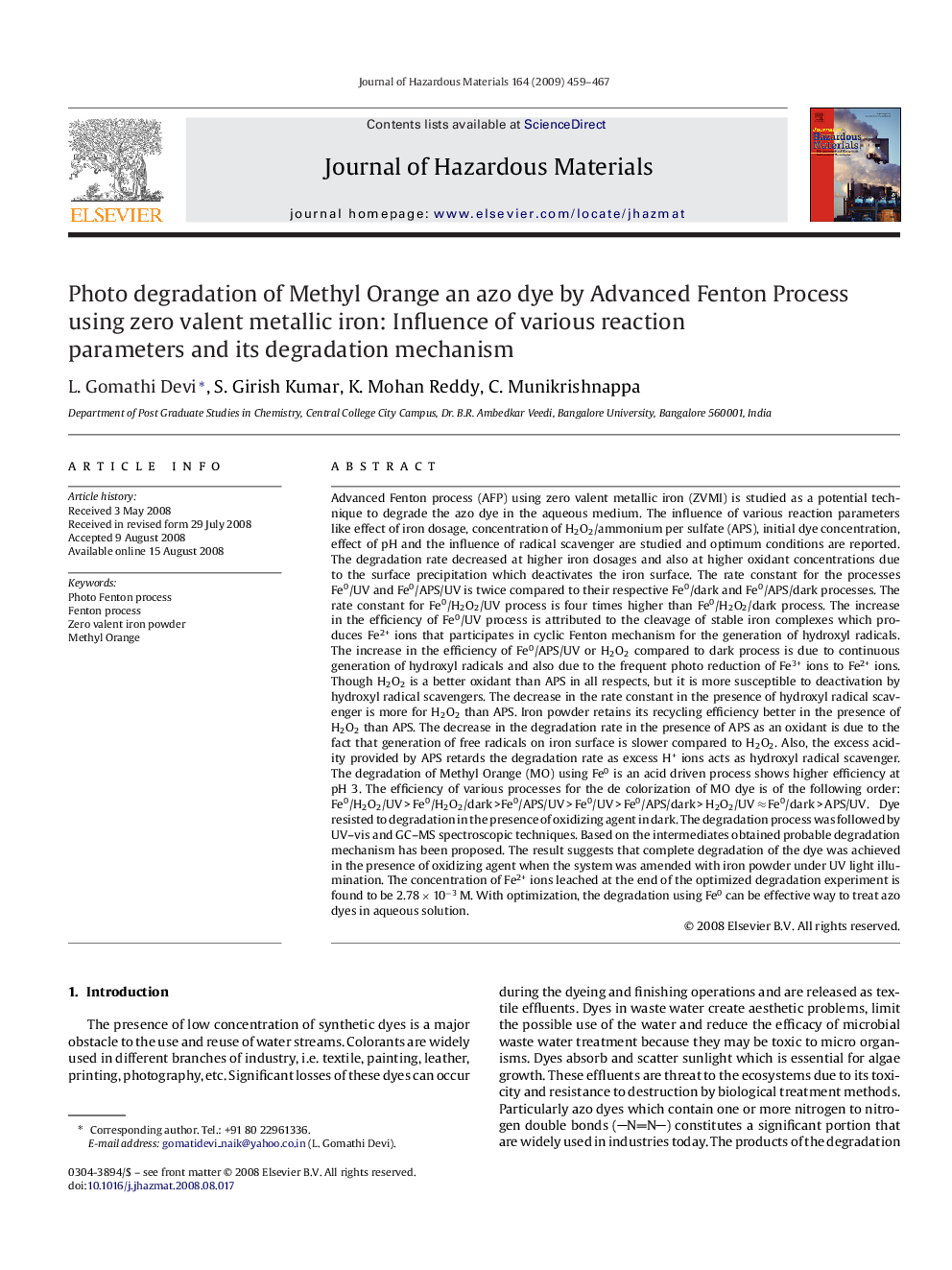| کد مقاله | کد نشریه | سال انتشار | مقاله انگلیسی | نسخه تمام متن |
|---|---|---|---|---|
| 582446 | 1453164 | 2009 | 9 صفحه PDF | دانلود رایگان |
عنوان انگلیسی مقاله ISI
Photo degradation of Methyl Orange an azo dye by Advanced Fenton Process using zero valent metallic iron: Influence of various reaction parameters and its degradation mechanism
دانلود مقاله + سفارش ترجمه
دانلود مقاله ISI انگلیسی
رایگان برای ایرانیان
موضوعات مرتبط
مهندسی و علوم پایه
مهندسی شیمی
بهداشت و امنیت شیمی
پیش نمایش صفحه اول مقاله

چکیده انگلیسی
Advanced Fenton process (AFP) using zero valent metallic iron (ZVMI) is studied as a potential technique to degrade the azo dye in the aqueous medium. The influence of various reaction parameters like effect of iron dosage, concentration of H2O2/ammonium per sulfate (APS), initial dye concentration, effect of pH and the influence of radical scavenger are studied and optimum conditions are reported. The degradation rate decreased at higher iron dosages and also at higher oxidant concentrations due to the surface precipitation which deactivates the iron surface. The rate constant for the processes Fe0/UV and Fe0/APS/UV is twice compared to their respective Fe0/dark and Fe0/APS/dark processes. The rate constant for Fe0/H2O2/UV process is four times higher than Fe0/H2O2/dark process. The increase in the efficiency of Fe0/UV process is attributed to the cleavage of stable iron complexes which produces Fe2+ ions that participates in cyclic Fenton mechanism for the generation of hydroxyl radicals. The increase in the efficiency of Fe0/APS/UV or H2O2 compared to dark process is due to continuous generation of hydroxyl radicals and also due to the frequent photo reduction of Fe3+ ions to Fe2+ ions. Though H2O2 is a better oxidant than APS in all respects, but it is more susceptible to deactivation by hydroxyl radical scavengers. The decrease in the rate constant in the presence of hydroxyl radical scavenger is more for H2O2 than APS. Iron powder retains its recycling efficiency better in the presence of H2O2 than APS. The decrease in the degradation rate in the presence of APS as an oxidant is due to the fact that generation of free radicals on iron surface is slower compared to H2O2. Also, the excess acidity provided by APS retards the degradation rate as excess H+ ions acts as hydroxyl radical scavenger. The degradation of Methyl Orange (MO) using Fe0 is an acid driven process shows higher efficiency at pH 3. The efficiency of various processes for the de colorization of MO dye is of the following order: Fe0/H2O2/UV > Fe0/H2O2/dark >Fe0/APS/UV > Fe0/UV > Fe0/APS/dark > H2O2/UV â Fe0/dark > APS/UV. Dye resisted to degradation in the presence of oxidizing agent in dark. The degradation process was followed by UV-vis and GC-MS spectroscopic techniques. Based on the intermediates obtained probable degradation mechanism has been proposed. The result suggests that complete degradation of the dye was achieved in the presence of oxidizing agent when the system was amended with iron powder under UV light illumination. The concentration of Fe2+ ions leached at the end of the optimized degradation experiment is found to be 2.78 Ã 10â3 M. With optimization, the degradation using Fe0 can be effective way to treat azo dyes in aqueous solution.
ناشر
Database: Elsevier - ScienceDirect (ساینس دایرکت)
Journal: Journal of Hazardous Materials - Volume 164, Issues 2â3, 30 May 2009, Pages 459-467
Journal: Journal of Hazardous Materials - Volume 164, Issues 2â3, 30 May 2009, Pages 459-467
نویسندگان
L. Gomathi Devi, S. Girish Kumar, K. Mohan Reddy, C. Munikrishnappa,